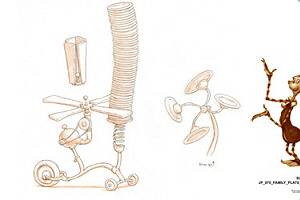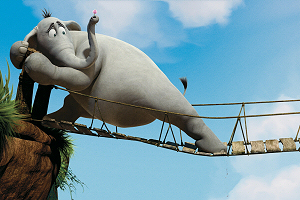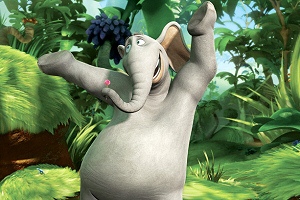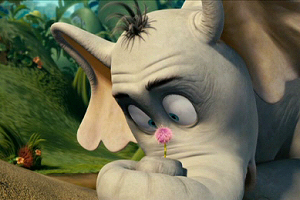NEWS
Dressing and grooming the characters
12 Mar 2008 By TNPihl (JCO Editor-In-Chief)
In Who-ville, fur is more than a fine coat of hair covering the skin – it’s a fashion statement. All the clothing in the tiny town is made of fur. The underlying geometry of a Who is what the Blue Sky fur team called a “peanut” – a naked Who under a suit, jacket, shirt, or dress of fur. The result is a very stylized fur look.
The fur-as-fashion notion comes straight from Dr. Seuss. “He had great renderings of fur in his books,” says Hayward, who points to a personal favorite dating back to the director’s childhood: “I remembered this one drawing in the book [Horton Hears a Who!] where there’s a Who wearing a fur shirt. I became obsessed with that character, maybe because my name is Hayward and the guy’s shirt has an ‘H’ on it,” he adds, with a laugh.
“The Whos go to the barber and get themselves trimmed a new suit,” Martino explains. And what’s new in the Who-ville fashion scene? “Neck tufts are very big,” he adds. “You’ll see lots of high turtlenecks and big collars.”
Everything from haute couture to functional garb is the product of a Who-ville barber – and Blue Sky Studios’ innovative fur and grooming teams. The fur and other unique visuals are a product of Blue Sky’s proprietary technology, the cornerstone of which is its ray tracing renderer, CGI Studio. The renderer, the fastest and most advanced of its type, allowed the filmmakers to manipulate the fur and environments, as if they were working with real lights on a real set, working with materials that behaved the way they do in the “real” world. It renders surfaces as if you could touch them.

© Blue Sky Studios
The renderer made possible the film’s huge crowd and mob scenes, featuring thousand of furry characters. But it was much more than fur and fashion for the film’s innovative R&D team, which also created a field of one-half-billion clovers for a pivotal scene. Vlad, after snatching the clover, on which rests the speck/Who-ville, out of Horton’s trunk, drops the precious flower into a field of about five hundred million – onehalf-billion—clovers stretching as far as the eye can see. One by one, Horton examines the clovers, carving his way through the immense field. It’s the ultimate “needle-in-ahaystack” scenario.
It’s a key moment in Seuss’ book, and a seminal one for Jimmy Hayward. “I thought it was incredible when Horton [in the book] ran up and screams, ‘NO!!!’, as the speck/clover floated down in the sea of clovers,” he relates. Hayward, like millions of other readers, couldn’t wait to turn the page and discover what came next – a memory he kept in mind as the scene was put together. As Horton realizes what’s happened, “we swing the camera all the way around him to reveal the massive clover field, from left to right, just like you’re turning a page,” Hayward explains. “It seemed like the right way to reveal this image.”
The Blue Sky R&D team also built into the renderer a proprietary algorithm that allowed the filmmakers to depict the wind blowing across the top of the clover field, just as wind would ripple across a Kansas wheat field. (Martino, a Midwesterner, has a particular fondness for this effect.)
The “hero” clover – the one housing Who-ville – was made up of a million hairs. For the clover field scene, the clovers closest to the camera had the full hair count or close to it; the “extra” or “supporting” closers averaged 50,000 hairs.
Squash and stretch...cause and effect:
Horton crosses a bridge – As the Mayor visits the dentist
Endeavoring to fully capture the wondrous and wildly imaginative worlds of Dr. Seuss, the filmmakers push the animation and rigging beyond the traditional boundaries of animation physics and character performance and believability.
They employ “squash-and-stretch” techniques to push Horton and the Mayor to extreme looks and movements. In traditional 2-D animation, squash-and-stretch gives characters elasticity and movement. But Hayward, Martino and the Blue Sky artists, animators and technicians take the technique to a new level.
Perhaps no scene better demonstrates the effectiveness of their squash-and-stretch techniques than when Horton – clover in tow – attempts to cross a long, rickety bamboo bridge overhanging on a deep gorge. At the same time, the Mayor is visiting the dentist, who is about to use a giant hypodermic needle on the Mayor. Hayward and Martino intercut the two hyper-precarious situations, creating an intricately constructed scene of cause-and-effect. Every Horton action (or stumble) has an equal (or equally crazy) reaction on the Mayor.

© Blue Sky Studios
In the sequence, the filmmakers employ squash-and-stretch to inflate Horton’s trunk – the ten-thousand-pound elephant (and eternal optimist), thinking air to be “lighter” than anything, believes he can float across the bridge like a dirigible. Needless to say, Horton’s expectations aren’t quite fulfilled. As Horton, inflated trunk and all, continues to stumble, leaving broken pieces of the bridge behind every step, the dentist’s hypodermic ends up in the Mayor’s arm instead of his mouth. The filmmakers again seize the opportunity to push the animation, stretching the mayor’s injected arm 30-feetlong. As the Mayor flees the office, his newly-elongated and flaccid limb accidentally smacks a few people across the face.
Hayward credits Jim Carrey with coming up with the idea for the situation: “Jim asked, ‘If an elephant was carrying your world around on a speck, where would be the worst place for the Mayor to be?’” remembers Hayward. “After suggesting something to do with power tools, Jim asked, ‘What if the Mayor was at the dentist – who’s wielding a hypodermic?’”
The animators also used squash-and-stretch for a “smear” effect, where, for example, a character’s legs move so quickly, they begin to smear – and look like they’re doubling or tripling in number.
“The elephant is listening”:
Sound and music come together in Dr. Seuss' Horton Hears a Who!
With the word “Hears” figuring so prominently in the title and storyline, it will come as no surprise that sound design and score were two of the film’s most critical elements. “The film’s central conceit is that the two main characters never meet – they can only hear one another,” Hayward elaborates. “Each has to believe what they’re hearing. And if that’s not the basis for a wonderful sound design, I don’t know what is.”
The film’s intricate and at times majestic marriage of sound design and music stems from the talents of two-time Oscar® winning sound designer Randy Thom (“The Incredibles,” “The Right Stuff”), who has also worked on films ranging from “Raiders of the Lost Ark” to “Ratatouille”; and composer John Powell, whose credits include “Shrek,” “Happy Feet,” “Ice Age: The Meltdown” – and the three “Bourne” films.

© Blue Sky Studios
Thom and Powell began collaborating unusually early in the process. “John and I brainstormed with the directors over a year before the movie’s release,” says Thom. “We all understand the film was going to be a real playground for sound. It’s a rare treat to share sounds with a composer, and we worked to integrate the two areas as much as possible.”
Thom endeavored to open the audiences’ ears to different perceptions of sounds – suspending disbelief that a microscopic man and a five-ton elephant could actually hear one another. The first contact between Horton and the Mayor involves complex sound transitions: As the speck flies through the air, we see the adrift Whos yelling (or, more accurately, “yelping”) for help. The filmmakers cut back and forth between the pointsof- view of Horton – whose over-sized ears pick up the “microscopic” sounds of tiny voices coming from the speck – and of the airborne Who-ville, where we hear the Whos full-bodied cries of surprise.
Looking to make contact with whoever is behind the tiny sounds, Horton bellows, “HELLO!” to the speck. We follow the sound wave as it travels down to the speck like a spaceship flying towards Earth. It hits the clover, passes through a blanket of clouds, and then disappears into a giant funnel, traveling through a maze of ducts – until it emerges from a drainpipe outside the Mayor’s office.
As the voice makes its journey through the atmosphere, Thom modulates it in various ways, such as altering its pitch and creating what he calls a “warbling sound” – all to complement the sound-wave visual. For its journey down the drainpipe, Thom adds a bunch of “clinks” and “clanks” and other metal-stretching sounds that accompany the continuing “Hello” sound.

© Blue Sky Studios
It’s a fun moment for the audience – and an astounding one for Horton. “We’re in the middle of some kind of amazing cosmic convergence!” Horton exclaims to the Mayor. “Two vastly different worlds miraculously crossing paths! Mine colossal, and yours miniscule, yet somehow we’ve managed to make contact!”
Sound takes center stage for the film’s epic climax, in which every Who comes together, using whatever they can to make noise to make themselves heard – and save themselves from certain doom. In unison, they shout, “WE ARE HERE! WE ARE HERE!” Help comes from an unexpected source: the Mayor’s son Jo-Jo, who contributes his Symphoniphone – a wondrous musical instrument he’s rigged from non-musical objects – to the multi-layered, city-wide symphony.
As the filmmakers put these finishing touches on the film, Audrey Geisel, wife of the late creator of these magical worlds, pondered what her husband would think of Horton Hears a Who! becoming a major CG animated motion picture. “He would probably be saying,” she shares, “that ‘Horton was so large and had such a big heart, the movie had to happen this way.’”
-- Source: Twentieth Century Fox Animation.
« Newer article | Overview | Older article »









